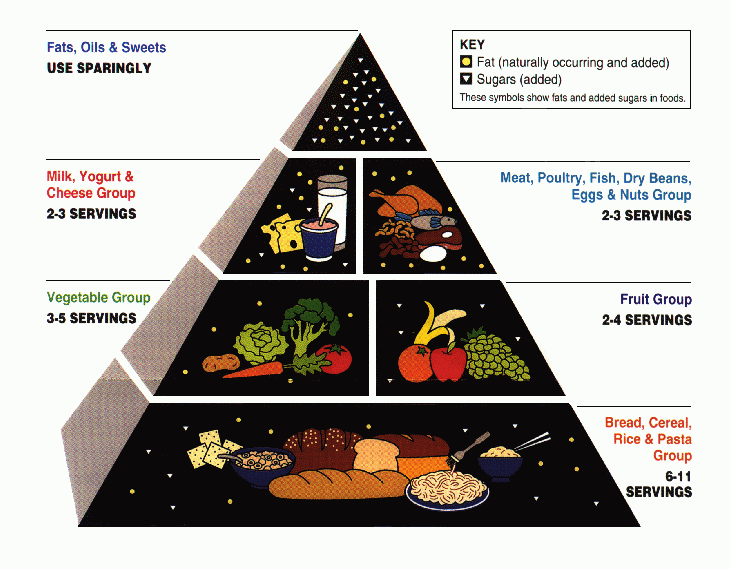By: Mackenzie Hannum
I have this vivid memory sitting in class in elementary school as the teacher walked us through the Time for Kids magazine. On the front cover was a picture of the infamous food pyramid.

Figure 1. Food Guide Pyramid Infographic (1992 Dietary Guidelines). Taken from the USDA’s Center for Nutrition Policy and Promotion.
But years later, the pyramid changed –the divisions were vertical and it’s all colorful (and there is someone running up the side of it?). Where are they going?

Figure 2. My Pyramid Infographic (2005 Dietary Guidelines). Taken from the USDA’s Center for Nutrition Policy and Promotion.
Wait a minute! Now it’s a plate!

Figure 3. My Plate Infographic (2010 Dietary Guidelines). Taken from the USDA’s Center for Nutrition Policy and Promotion.
What happened to the pyramid? What am I supposed to abide by? Who decided I should eat a handful of grains? Why do the guidelines keep changing? (And why was it a pyramid and now it is a plate?)
Growing up, as a consumer whose only exposure to the dietary guidelines was through those various infographics, it was confusing! I could not make sense of it. It wasn’t until I started my doctoral degree in food science that the pyramid started to make more sense. I took a class about foods for health and learned what all goes into establishing the dietary guidelines by someone who helped create them.
As we approach 2020, we also approach a new set of dietary guidelines which are renewed every five years. Fun fact: the US Dietary Guidelines was first established in 1980 (forty years ago!). It is managed by both the US Department of Health and Human Services and the US Department of Agriculture. The goal of the guidelines is to guide Americans towards healthier food choices to respond to a trend in chronic diseases, overweight, and obesity, as well as contradicting public opinions regarding nutrition and health. The guidelines directly impact us as consumers, but will also drastically impact a variety of players – the private sector, food industry, agriculture, global market, etc. There was and still is a need to systematically review the present research and compile it in a document to help guide our citizens in making thoughtful decisions regarding their food choices.
In this blog post, I hope to lift the curtain and guide you through all that goes behind those seemingly simple infographics – even though they represent years of research, multiple subcommittees, and reviews. I hope I can enlighten you as the reader on how decisions are made to establish the dietary guidelines.
There are five main steps to creating the dietary guidelines: focus, build, compile, create and educate.
Step 1: Focus
Imagine the wealth of information and scientific research that has been produced in the past five years, let alone 40 years since the first dietary guidelines in 1980. There is a lot. Research evolves over time as new findings come to light which might influence the guidelines. Therefore, the first step in the process is to establish the relevant topics and questions of interest. There is an opportunity to provide public comments on what you as a consumer or industry member want to see addressed in the new guidelines. These topics and questions will not only guide the final draft but also shape the areas of scientific expertise needed on the scientific committee, which brings me to the next step.
Step 2: Build
Build the scientific advisory committee. At Ohio State, I had the privilege of learning firsthand from someone who served on this committee. The advisory committee is nominated and selected and start their term the year before the guidelines are drafted. Twenty nationally recognized researchers are selected for their wide expertise and diverse backgrounds. Here is more information about that process and the current 2020 advisory committee. This committee is tasked to systematically review the present research and provide conclusions and recommendations, bringing me to the following step.
Step 3: Compile
Compile the scientific report. The committee will perform a rigorous and systematic review of current nutrition and food research. This process is highly analytical and regulated in order to ensure an unbiased interpretation of the research and also filter out poorly conducted research. They examine the overall scope of the research question, the population, any interventions/exposures, comparators or outcomes of interest. They utilize a strict screening plan for their literature search with an explicit list of inclusion and exclusion criteria in order to select for research articles in an unbiased manner. Some questions they consider when looking through the research:
- Has the research been conducted in vivo (alive) models? With healthy human participants?
- Has a clinical study been conducted with human subjects? Studies with human participants provide more authority when it comes to the strength of evidence of scientific research.
- Is the sample representative of the general population? What was the sample size?
- What experimental design did the researchers utilize? This will impact the ability of a research study to determine cause and effect and should be taken under consideration when drafting the dietary guidelines.
- Did the researcher report on an actual outcome or just an intermediate biomarker?
- Was there any potential bias due to sponsorship?
This year the committee is focusing on the following topics of interest: dietary patterns, pregnancy and lactation, birth to 24 months, beverages and added sugars, dietary fats and seafood, frequency of eating and lastly, data analysis and food pattern modeling cross-cutting working group. The committee will meet multiple times over the year to review and summarize the evidence in a report that will be submitted to the secretaries of the Department of Human and Health Services and Department of Agriculture (USHHS 2015). It is important to note that this whole process is viewed as transparent, accessible and systematic. Multiple iterations for public comments are encouraged. You can even read the whole report yourself. Here is the scientific report from 2015.
Step 4: Create
Create the guidelines. USDA and HHS will consider the report, along with input from federal agencies and the public to develop evidence-based guidance on choosing a healthy diet that promotes health for all Americans. This document has important economic and food policy implications that could have a ripple effect on the industry. Each recommendation, whether it is to increase or decrease consumption of a product, will result in a reallocation of resources and therefore, there are additional opportunities for the public to comment on the guidelines. The federal agencies will take it all into consideration and make the conclusive decision.
Step 5: Educate
Educate the public. Lastly, after the current breadth and depth of nutritional and health research has been reviewed and the guidelines have been drafted, the recommendations need to be implemented. However, a major implementation challenge is dispersing the information in a way that can be communicated to the broader public, all of which have different educational backgrounds, levels of literacy, and access to information. This challenge often results in the construction of extremely simple and diluted visuals, such as the MyPlate or Food Pyramid, that might overshadow the hard, scientific process that was being conducted (Wilde 2013). However, hopefully now you have a better understanding of truly all the work that goes into making these visuals and producing the guidelines.
Conclusion
In conclusion, through the five steps (focus, build, compile, create and educate) the dietary guidelines are established to reflect the current body of nutrition science and help Americans make healthy food choices. In my journey of lifting the curtain back, I was initially surprised to learn how transparent they make the whole process and they constantly stress the ability to submit comments, even providing the opportunity to submit oral comments during some of the committee’s meetings. I encourage you all to check out their website to stay up to date with the progress of the 2020 guidelines.
(P.S. Come check out our Instagram and Facebook for more weekly IFTSA updates, news, and food science!)
References
Wilde, P. 2013. Food Policy in the United States: An Introduction. Earthscan/Routledge. ISBN-10: 1849714290; ISBN-13: 978-1849714297
USHHS Charter 2015. Dietary Guidelines Advisory Committee.

Mackenzie Hannum | Linkedin
Mackenzie graduated with a B.S from The Ohio State University in Food Science and couldn’t get enough of it so decided to stay at Ohio State to pursue her PhD in Food Science with the focus on sensory science. Overall her research investigates panelist engagement and ways to improve sensory methodology. Fun fact about Mackenzie is that her 5th grade science fair project explained the concept of the 5 basic tastes so in a way she has come full circle. As much as she prides herself now on being a true foodie, ready to try all things sans olives, she will admit her two all-time, indisputable favorite foods are pretzels (any kind) and plain bagels. Truly…if she was stranded on a deserted island with only one food item it would be a tough battle between the two but pretzels would win out. Hard, soft, sourdough, sticks—you name it!






What an excellent overview! Thanks for the insight into this process and the key topics for 2020.
Great article Kenzie! Interesting to learn the process. (I used to love Time for Kids as well!)